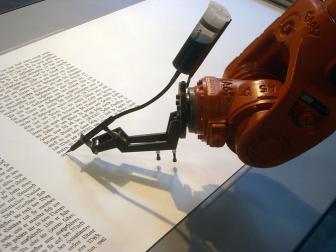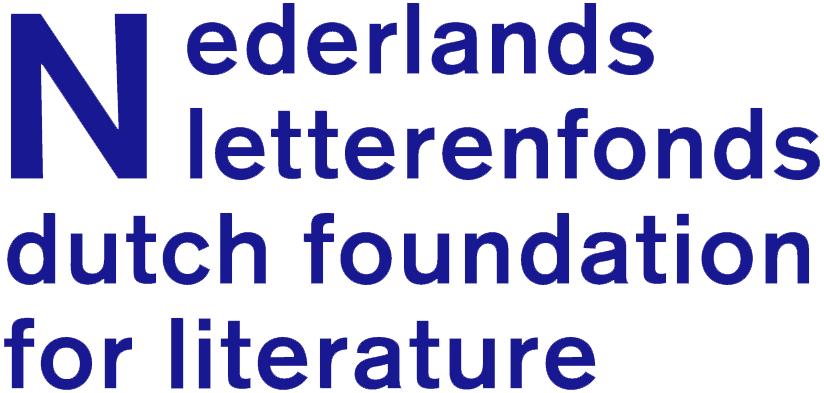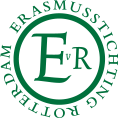Artikel
artificial intelligence and the art of poetry
Can computers write free verse?

6 november 2018
There are also recent developments in building algorithms that can do the work of curation, as Israeli poet Eran Hadas has shown. Similar algorithms have been applied to marking student papers with great success.
The Question
Given that there are now some computer applications that compose tanka poems to the extent that some, if not all, of them may be perceived as human-made tankas, is the same possible with free form poems?
Currently the answer is Yes! One can see examples on Bot or Not web pages in links below where one is invited to guess whether poems are written by a robot or a poet. There are poem-generating programs. There are also other web sites featuring examples of computer poetry. The interesting thing here is that it is not always easy to distinguish between human made and machine made poems. Examples are of plausible imitations of Emily Dickinson produced by an RKCP algorithm, as well as authentic Gertrude Stein poems that appear as if they were computer generated. Clearly computer poetry has been developed with not just fixed form short verse in mind. The deeper question is about the direction of research and the types of algorithm being applied to generate poetry today. AI algorithms using Natural Language Processing (NLP) have been used to morph two sentences, producing no very remarkable poetry [2]. Using AI, Google tries to predict the next sentences of dead authors [3]. Google is using Deep Neural Networks (DNN) algorithms to learn from the authors digitally captured in Project Gutenberg. Focusing on an author's body of work, Google is beginning to analyse an ouevre in order to predict the author's word choice, thinking and style.
A PhD student, J Nathan Matias at MIT Media Labs, has worked with an intelligent keyboard by SwiftKey [4] trained especially on the sonnets of Shakespeare, to coauthor a plausible Shakespearean sonnet [5]. The new sonnet was written by choosing words purely from the next-word suggestions generated by the algorithm. Here is an excerpt of the man-machine made sonnet:
When I in dreams behold thy fairest shade
Whose shade in dreams doth wake the sleeping morn
The daytime shadow of my love betray'd
Lends hideous night to dreaming's faded form
Machine learning remains a collaboration between people and machines – with the input of each enhancing and extending the other's powers. AI can be evolved to produce instances of free verse, à la Pound or T. S. Eliot or Dylan Thomas’ Under Milk Wood. Using statistical analysis of the authors and their styles, applying DNN per Google's approach should be able to deliver the next sentence for these authors and with the help of predictive keyboards like Swiftkey, and a poetically astute human collaborator, the next sentence or line can be followed by another and another to deliver a whole piece. But to create whole pieces of free verse unaided, what could be missing for that to be possible? Would we need to create the author first?
Free Verse Architecture
I would argue that we primarily need an architecture: a framework of modern free verse and an architected roadmap to achieve elements of that modern framework for poesy. Let's look at some elements of that framework. Free verse does not have a given pattern, but an interplay of form and content.
Content
Can AI generate metaphors? What about metonymy and other figurative language? Ultimately metaphor and metonymy are semantic substitutions, which can be part of the cognitive component of AI algorithms.
For instance, sunshine may be the metaphoric substitute for the face of a lover, or a sail the metonymic substitute for a boat. There are dead and classified metaphors which become part of the language. But when it comes to fresh figures of speech, would developments in cognitive ML open the path towards a metaphor engine? The output of such an engine must be able to demonstrate how it came to propose a given metaphor or metonymy. This would be one of the architecture building blocks of free verse AI engine. The computer app should also use the homophonic dictionary and perhaps a thesaurus as input in order to be able to discover all polysemies. These devices would help create open verse, which can be reinterpreted and reprocessed by readers.
Form
Can a genetic algorithm generate a free form verse? What are the elements of form here?
The key behind short free form is the micro rhythm. Elements of speech are key here. Text to speech and speech to text could be used to establish kinetics of stress.
What is characteristic of free verse is that form is created each time as a function of or as a pointer to its content.
Free verse can be represented as such: Form follows Content.
In contrast, tanka metre (57577 syllables) requires a fixed form that can be set as a constraint for the algorithm to arrive at through optimising speech element: Content follows Form [6].
Here is an interesting example of content dictating form: Eran Hadas' generation of a haiku version of some lines from Genesis in the Old Testament.
a-1
Abyss and spirit
God she is floating upon
The face of waters
a-2
Floating upon the
Face of the waters and so
Said God Let there be
a-3
Let there be a sky
Inside the waters and let
It divide waters
a-4
It that is the sky
Shall separate the waters
That are underneath
a-5
Those are the waters
That are underneath the sky
And between waters
What distinguishes free verse as defined by Pound is that it follows a rhythmic protocol other than classical verse (the superset of tankas). Free verse has a free non-metrical prosody of syntax and notation. On the one hand it draws on patterns of speech; on the other hand it depends on line breaks and page layout. We can call these characteristics syntax and notation respectively. Syntax follows speech but notation is more arbitrary (so perhaps this can be input into the algorithim ).
Free Verse Architecture aims to describe a distillation of all the components of free prosody from generic categories like form and content to figures of style and micro-rhythm [7].
It is also worth noting that the mind of the poet is capable of incubating new memes rather than replicating old ones. The poet's mind is in fact a meme factory. We are therefore looking for a meme engine in the genre of free verse.
There are intermediate or transition architectures to develop further. AI as writing aid in the form of intelligent keyboards and manual algorithms for co-creating verse with AI [8] described above is an intermediate case in point and will continue to be a useful development, giving poets new power tools to write great work. However these bricks still need human intervention and assemblage.
The roadmap to free verse AI
The roadmap to a free verse AI engine is a parallel series of programmes (the poetic portfolio) that produce the components or the building blocks of free verse architecture. The parallel series of programmes or the poetic portfolio, initially developed as a series, can then be brought together into an integrated neural design.The closed form verse engine may be close at hand. But the open form covariant content verse engine is a figurative mile or two off.
In conclusion (a short blueprint)
A free verse AI engine could well have to adopt multiple engines, be they form, content and quite possibly authoring, the latter orchestrating a reading list of images, sounds and words. This content and form would then be interacting either through collaboration or competitive board games whose narrative is semi-guided by preset rules established by human intelligence.
A free verse architecture framework and a roadmap would contextualise and aesthetically validate the building blocks of the meme engine for free verse. Simulation thus enters the realm of reality through the act of human interaction. Ultimately, poetry exists through its human context. LINKS
Bot or not?
NOTES
[1] AI Algorithms iterate to converge on a given pattern or form following certain rules. They are fed with rule and samples (training materials, like the Japanese Wikipedia) iterating from initial conditions to a convergent output. Which can just as well be a new form of protein molecule or a new piece of music. But in the latter case they are imitative of a certain style like Bach's. Can the same be created with T.S. Eliot?
[2] Google's AI has written some amazingly mournful poetry
[3] Google wants to predict the next sentences of dead authors
[4] Swiftkey is a UK start up recently acquired by Microsoft, aiming to enhance the interactions of keyboards and people.
[5] Read The Sonnet Co-Authored By Shakespeare, An MIT PhD Student & A Machine-Learning Algorithm
[6] Generative tools produce output based on your goals and constraints. What are the goals of poetry? Constraints are like the syllabic counts of a tanka e.g. 57 577. If the Goal is desirability how can we establish that? What are the goals of linguistic poetry? Linguistic events. Poetic events. Events and ontology.
[7] Given the tanka producing machines we can conceive of the same algorithm having its 57577 constraint and replace it with an auto generated syllabic line series and generate blank Verse or Verse structures a la Prufrock. And then what do we find? The first answer is that we find a pseudo modern verse because in this format the content still follows form, though be it pre-generated or degenerated imitations. We are still one figurative mile away from being able to choose algorithms that can solve for form and content in a covariance. Because this is what happens to the poetic subject in the best neo modern Verse form and contact co evolve (in the meme infested mind of the poet)
[8] Example: use the Google keyboard to write a line using words based on the proposed words upon typing the first two letters of the word you have in mind and see where it takes you.
It is possible to assert about human-machine symbiosis that we have arrived at a new era. Machines are no longer parasitic to the human operator. They are increasingly autonomous black boxes with various outputs simulating forms of consciousness – scientific, musical or poetic. Emphasis is placed on “simulating" as far as the rest of this column goes.
From guessing the next word to guessing the next tanka, our predictive tools, like intelligent keyboards, have come a long way, applying statistical techniques to predict the next word as we type. Some of us are developing machine learning using genetic algorithms [1] to generate the next imitation of Bach or Brahms, or indeed the next synthetic protein that can join the ranks of nano-robots.
Literature is inherently representational. Short verses of fixed form, for example, simulated tankas or the translated Rubaiyat, only require fixed structures with simple rules of rhythm, rhyme and metre that can act as constraints to the neural engines with Natural Language Processing and Machine Learning (ML) algorithms. Tankas have thus been machine outputs curated by a human editor who applies a test of significance. And once published, readers are there to give it another test: Does the piece induce the perception of a poet authoring the text? The point is that the machine Tanka in this case goes through two Turing Tests: one by the curator/editor, and one by the reader.
There are also recent developments in building algorithms that can do the work of curation, as Israeli poet Eran Hadas has shown. Similar algorithms have been applied to marking student papers with great success.
The Question
Given that there are now some computer applications that compose tanka poems to the extent that some, if not all, of them may be perceived as human-made tankas, is the same possible with free form poems?
Currently the answer is Yes! One can see examples on Bot or Not web pages in links below where one is invited to guess whether poems are written by a robot or a poet. There are poem-generating programs. There are also other web sites featuring examples of computer poetry. The interesting thing here is that it is not always easy to distinguish between human made and machine made poems. Examples are of plausible imitations of Emily Dickinson produced by an RKCP algorithm, as well as authentic Gertrude Stein poems that appear as if they were computer generated. Clearly computer poetry has been developed with not just fixed form short verse in mind. The deeper question is about the direction of research and the types of algorithm being applied to generate poetry today. AI algorithms using Natural Language Processing (NLP) have been used to morph two sentences, producing no very remarkable poetry [2]. Using AI, Google tries to predict the next sentences of dead authors [3]. Google is using Deep Neural Networks (DNN) algorithms to learn from the authors digitally captured in Project Gutenberg. Focusing on an author's body of work, Google is beginning to analyse an ouevre in order to predict the author's word choice, thinking and style.
A PhD student, J Nathan Matias at MIT Media Labs, has worked with an intelligent keyboard by SwiftKey [4] trained especially on the sonnets of Shakespeare, to coauthor a plausible Shakespearean sonnet [5]. The new sonnet was written by choosing words purely from the next-word suggestions generated by the algorithm. Here is an excerpt of the man-machine made sonnet:
When I in dreams behold thy fairest shade
Whose shade in dreams doth wake the sleeping morn
The daytime shadow of my love betray'd
Lends hideous night to dreaming's faded form
Machine learning remains a collaboration between people and machines – with the input of each enhancing and extending the other's powers. AI can be evolved to produce instances of free verse, à la Pound or T. S. Eliot or Dylan Thomas’ Under Milk Wood. Using statistical analysis of the authors and their styles, applying DNN per Google's approach should be able to deliver the next sentence for these authors and with the help of predictive keyboards like Swiftkey, and a poetically astute human collaborator, the next sentence or line can be followed by another and another to deliver a whole piece. But to create whole pieces of free verse unaided, what could be missing for that to be possible? Would we need to create the author first?
Free Verse Architecture
I would argue that we primarily need an architecture: a framework of modern free verse and an architected roadmap to achieve elements of that modern framework for poesy. Let's look at some elements of that framework. Free verse does not have a given pattern, but an interplay of form and content.
Content
Can AI generate metaphors? What about metonymy and other figurative language? Ultimately metaphor and metonymy are semantic substitutions, which can be part of the cognitive component of AI algorithms.
For instance, sunshine may be the metaphoric substitute for the face of a lover, or a sail the metonymic substitute for a boat. There are dead and classified metaphors which become part of the language. But when it comes to fresh figures of speech, would developments in cognitive ML open the path towards a metaphor engine? The output of such an engine must be able to demonstrate how it came to propose a given metaphor or metonymy. This would be one of the architecture building blocks of free verse AI engine. The computer app should also use the homophonic dictionary and perhaps a thesaurus as input in order to be able to discover all polysemies. These devices would help create open verse, which can be reinterpreted and reprocessed by readers.
Form
Can a genetic algorithm generate a free form verse? What are the elements of form here?
The key behind short free form is the micro rhythm. Elements of speech are key here. Text to speech and speech to text could be used to establish kinetics of stress.
What is characteristic of free verse is that form is created each time as a function of or as a pointer to its content.
Free verse can be represented as such: Form follows Content.
In contrast, tanka metre (57577 syllables) requires a fixed form that can be set as a constraint for the algorithm to arrive at through optimising speech element: Content follows Form [6].
Here is an interesting example of content dictating form: Eran Hadas' generation of a haiku version of some lines from Genesis in the Old Testament.
a-1
Abyss and spirit
God she is floating upon
The face of waters
a-2
Floating upon the
Face of the waters and so
Said God Let there be
a-3
Let there be a sky
Inside the waters and let
It divide waters
a-4
It that is the sky
Shall separate the waters
That are underneath
a-5
Those are the waters
That are underneath the sky
And between waters
What distinguishes free verse as defined by Pound is that it follows a rhythmic protocol other than classical verse (the superset of tankas). Free verse has a free non-metrical prosody of syntax and notation. On the one hand it draws on patterns of speech; on the other hand it depends on line breaks and page layout. We can call these characteristics syntax and notation respectively. Syntax follows speech but notation is more arbitrary (so perhaps this can be input into the algorithim ).
Free Verse Architecture aims to describe a distillation of all the components of free prosody from generic categories like form and content to figures of style and micro-rhythm [7].
It is also worth noting that the mind of the poet is capable of incubating new memes rather than replicating old ones. The poet's mind is in fact a meme factory. We are therefore looking for a meme engine in the genre of free verse.
There are intermediate or transition architectures to develop further. AI as writing aid in the form of intelligent keyboards and manual algorithms for co-creating verse with AI [8] described above is an intermediate case in point and will continue to be a useful development, giving poets new power tools to write great work. However these bricks still need human intervention and assemblage.
The roadmap to free verse AI
The roadmap to a free verse AI engine is a parallel series of programmes (the poetic portfolio) that produce the components or the building blocks of free verse architecture. The parallel series of programmes or the poetic portfolio, initially developed as a series, can then be brought together into an integrated neural design.The closed form verse engine may be close at hand. But the open form covariant content verse engine is a figurative mile or two off.
In conclusion (a short blueprint)
A free verse AI engine could well have to adopt multiple engines, be they form, content and quite possibly authoring, the latter orchestrating a reading list of images, sounds and words. This content and form would then be interacting either through collaboration or competitive board games whose narrative is semi-guided by preset rules established by human intelligence.
A free verse architecture framework and a roadmap would contextualise and aesthetically validate the building blocks of the meme engine for free verse. Simulation thus enters the realm of reality through the act of human interaction. Ultimately, poetry exists through its human context. LINKS
Bot or not?
NOTES
[1] AI Algorithms iterate to converge on a given pattern or form following certain rules. They are fed with rule and samples (training materials, like the Japanese Wikipedia) iterating from initial conditions to a convergent output. Which can just as well be a new form of protein molecule or a new piece of music. But in the latter case they are imitative of a certain style like Bach's. Can the same be created with T.S. Eliot?
[2] Google's AI has written some amazingly mournful poetry
[3] Google wants to predict the next sentences of dead authors
[4] Swiftkey is a UK start up recently acquired by Microsoft, aiming to enhance the interactions of keyboards and people.
[5] Read The Sonnet Co-Authored By Shakespeare, An MIT PhD Student & A Machine-Learning Algorithm
[6] Generative tools produce output based on your goals and constraints. What are the goals of poetry? Constraints are like the syllabic counts of a tanka e.g. 57 577. If the Goal is desirability how can we establish that? What are the goals of linguistic poetry? Linguistic events. Poetic events. Events and ontology.
[7] Given the tanka producing machines we can conceive of the same algorithm having its 57577 constraint and replace it with an auto generated syllabic line series and generate blank Verse or Verse structures a la Prufrock. And then what do we find? The first answer is that we find a pseudo modern verse because in this format the content still follows form, though be it pre-generated or degenerated imitations. We are still one figurative mile away from being able to choose algorithms that can solve for form and content in a covariance. Because this is what happens to the poetic subject in the best neo modern Verse form and contact co evolve (in the meme infested mind of the poet)
[8] Example: use the Google keyboard to write a line using words based on the proposed words upon typing the first two letters of the word you have in mind and see where it takes you.
© Abol Froushan
Sponsors
























